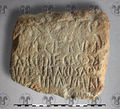TV-1.2: Difference between revisions
No edit summary |
|||
| Line 22: | Line 22: | ||
Pictures in {{bib|Pellegrini & Prosdocimi 1967}}: 400 (photo) and {{bib|Morandi 1999}}: fig. 5, 7, 32 and 33 (photos) and 11 and 34 (drawings). | Pictures in {{bib|Pellegrini & Prosdocimi 1967}}: 400 (photo) and {{bib|Morandi 1999}}: fig. 5, 7, 32 and 33 (photos) and 11 and 34 (drawings). | ||
The Latin inscription was only detected in 1962, after the slab had been taken out of the church wall, where it had been placed with the [[index::TV-1. | The Latin inscription was only detected in 1962, after the slab had been taken out of the church wall, where it had been placed with the [[index::TV-1.1|allegedly Raetic inscription]] facing outward. {{bib|Pellegrini 1964|Pellegrini}}, who was the first to mention the finding in 1964, addressed the possibility of a bilingua and expressed his hope for the Latin text shedding light on the Raetic (p. 78). He announced a soon-to-be-published edition of the text by Franco Sartori, professor at the Università di Padova, but although the slab was immediately examined and restored at Padua, no edition has been published. The text is noted and reproduced in the {{bib|Pellegrini & Prosdocimi 1967|Lingua Venetica}} with the comment "di dubbia trascrizione" (p. 400); similarly, {{bib|LIR|Mancini}} refers to "un'iscrizione di età romana di difficile lettura" (p. 278). | ||
The first to attempt a reading was Alessandro {{bib|Morandi 1999|Morandi}}. His interpretation of the text as christian and consequent dating to the 3rd-4th c. AD demonstrates that we are not concerned with a bilingua, but that the stone was reused (as already assumed by {{bib|Pellegrini 1985}}: 115 f.). | The first to attempt a reading was Alessandro {{bib|Morandi 1999|Morandi}}. His interpretation of the text as christian and consequent dating to the 3rd-4th c. AD demonstrates that we are not concerned with a bilingua, but that the stone was reused (as already assumed by {{bib|Pellegrini 1985}}: 115 f.). | ||
{{bibliography}} | {{bibliography}} | ||
Revision as of 18:52, 31 October 2014
| Inscription | |
|---|---|
| Transliteration: | ? |
| Original script: | ? |
|
| |
| Object: | TV-1 slab (sandstone) (Inscriptions: TV-1.1, TV-1.2) |
| Position: | |
| Script: | Latin script |
| Direction of writing: | dextroverse |
| Letter height: | 33 cm <br /> – 4 cm |
| Craftsmanship: | engraved |
| Current condition: | damaged, fragmentary |
| Date of inscription: | |
| Date derived from: | |
|
| |
| Language: | unknown |
| Meaning: | unknown |
|
| |
| Alternative sigla: | none |
Images
Commentary
First published by Morandi 1999: 99 ff.
Pictures in Pellegrini & Prosdocimi 1967: 400 (photo) and Morandi 1999: fig. 5, 7, 32 and 33 (photos) and 11 and 34 (drawings).
The Latin inscription was only detected in 1962, after the slab had been taken out of the church wall, where it had been placed with the allegedly Raetic inscription facing outward. Pellegrini, who was the first to mention the finding in 1964, addressed the possibility of a bilingua and expressed his hope for the Latin text shedding light on the Raetic (p. 78). He announced a soon-to-be-published edition of the text by Franco Sartori, professor at the Università di Padova, but although the slab was immediately examined and restored at Padua, no edition has been published. The text is noted and reproduced in the Lingua Venetica with the comment "di dubbia trascrizione" (p. 400); similarly, Mancini refers to "un'iscrizione di età romana di difficile lettura" (p. 278).
The first to attempt a reading was Alessandro Morandi. His interpretation of the text as christian and consequent dating to the 3rd-4th c. AD demonstrates that we are not concerned with a bilingua, but that the stone was reused (as already assumed by Pellegrini 1985: 115 f.).
Bibliography
| LIR | Alberto Mancini, Le Iscrizioni Retiche [= Quaderni del dipartimento di linguistica, Università degli studi di Firenze Studi 8–9], Padova: Unipress 2009–10. (2 volumes) |
|---|
